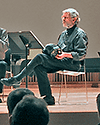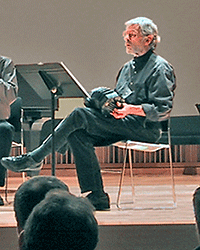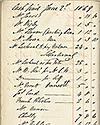Posted 15 November 2007
The Victorian Concertina:
Some Issues Relating to Performance1
Allan W. Atlas
From the Introduction:
Present-day players of the ‘English’ concertina (see Fig. 1 [photographs of Victorian concertinas
in the collection of the author] 2 )
must make a number
of important decisions when delving into and performing the large repertory of
art music that was written for the instrument in Victorian
England.3
These
decisions become especially critical for those who would perform the music in a
manner that may at least approximate the way it may have sounded in the
nineteenth century. Briefly, there are three basic decisions to be made. The first
two concern the choice of instrument: (1) modern instrument or period (Victorian)
instrument; and (2) if the latter, what kind of instrument in terms of reeds (type
of metal), tuning, structure of the bellows and number of buttons. The third
decision, on the other hand, has to do with a fundamental question of playing
technique: should we use three or four fingers of each hand?
Before considering these issues, however, we should clear the air about two
matters, the first of which concerns the name and nature of the instrument itself.
The word ‘English’ in English concertina refers to two things: (1) the instrument’s
place of origin and (2) the characteristics of the system by which it works, which
distinguish it from other types of concertinas. Developed circa 1830 – thus during
the quarter-century that saw the invention of a slew of free-reed
instruments4
– by
the soon-to-be-famous physicist Sir Charles Wheatstone
(1802–1875),5
the English
concertina is a fully chromatic instrument on which each button produces a single
pitch regardless of the direction in which the bellows are moving. By the late 1840s,
the most popular version of the instrument was a 48-button treble with a range
of g–c′′′′, though tenor, baritone, and bass models – their lowest pitches being c,
G, and C, respectively – were also available and were often used in concertina
ensembles. Finally, with contributions to its repertory by the likes of George
Alexander Macfarren, Julius Benedict, John Barnett and Bernhard Molique, the
English concertina was the only type of concertina that found a home in Victorian
art-music circles, both in the recital hall and in the drawing rooms and salons of
the middle and upper
classes.6
Clearing the air around the second matter will no doubt cause some readers to
wonder why I’ve bothered to write this little essay in the first place. We can
probably count the number of concertinists who cultivate the concertina’s
Victorian art-music repertory on the fingers of – to err on the high side – two
hands. Who, then, might find any of what I have to say interesting? In fact, I can
imagine three groups of readers, each of which brings a different concertinarelated
background to the topic: (1) those who have had the opportunity to hear
snatches of the Victorian concertina repertory (surely the smallest of the three
groups); (2) musicologists and others for whom the concertina – any kind of
concertina – is an instrument associated mainly with pubs, street corners, village
greens and whaling ships (surely the venues with which the concertina has
generally been associated in both literature and films, usually – and sometimes
quite inaccurately – in order to introduce a bit of
‘local colour’),7
and who might,
therefore, find it interesting to learn that such questions even exist (as they have
quite publicly for the more ‘canonic’ instruments); and (3) the many concertina
players8
who, while most at home with hornpipes, Morris dances and sea shanties,
are nevertheless interested in the history of the instrument and might find it
worthwhile to mull over at least one person’s view about some of the decisions
that go into the performance of its Victorian repertory.
Finally, to wrap up our discussion about concertina basics: though we shall not
be dealing with the layout of the concertina’s button board until we reach our
discussions about tuning and fingering, it is just as well to introduce it here. Figure
2 presents the layout of the standard 48-button treble. Three things are worthy of
note: (1) all notes that appear on the lines or ledger lines of the staff are in the left
hand, while those that fall in the spaces or between ledger lines are in the right
hand; (2) the two inner vertical rows of each hand are equivalent to the white notes
of the keyboard, whereas the two outer vertical rows provide the black notes; and
(3) there are separate buttons for the enharmonic notes G# and Ab, on the one
hand, and D# and Eb, on the other (except in the highest octave, where the right
hand lacks a separate button for a′′′b); as we shall see, these duplicate buttons for
notes that are enharmonic equivalents are a vestige of the period in which the
concertina employed a mean-tone temperament with fourteen separate notes to
the octave (see p. 48).
Continue reading the entire article:
-
 The Victorian Concertina:
The Victorian Concertina:
Some Issues Related to Performance
-
by Allan W. Atlas
-
The article is a single PDF file which opens immediately in a browser.
Click on the title or picture to open the document, or
right-click and choose “Save Target As …”
to save a personal copy of the entire file to your computer (file size is about 2.6 megabytes).
30 pages including photographs and musical examples.
From Nineteenth-Century Music Review, 3/2 (2006),
pages 33–62, published by Ashgate Publishing Ltd.
-
Posted 15 November 2007
-
» read full document (pp. 33–62) in pdf (or right-click to download)
-
Have feedback on this article?
Send it to the author.
The original version of this article appeared in
Nineteenth-Century Music Review, 3/2 (2006),
pages 33–62, published by Ashgate Publishing Ltd.
Reprinted from the Concertina Library
http://www.concertina.com
© Copyright 2000– by Ashgate Publishing Ltd. and Allan W. Atlas





